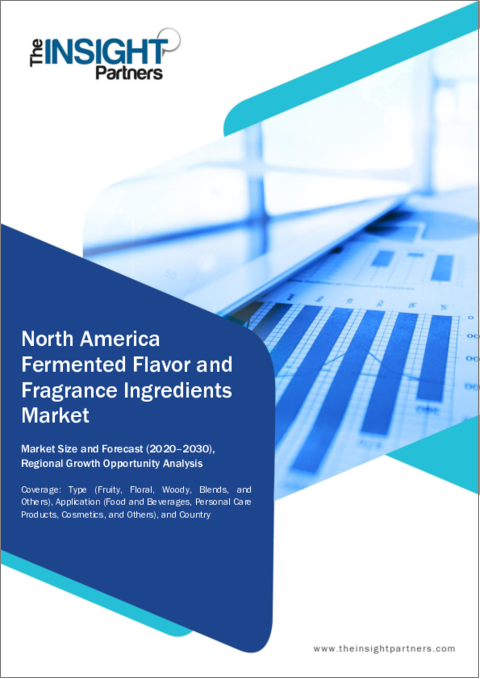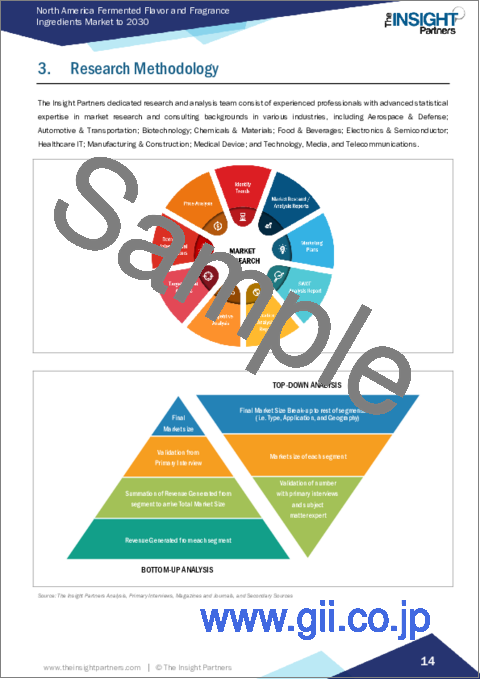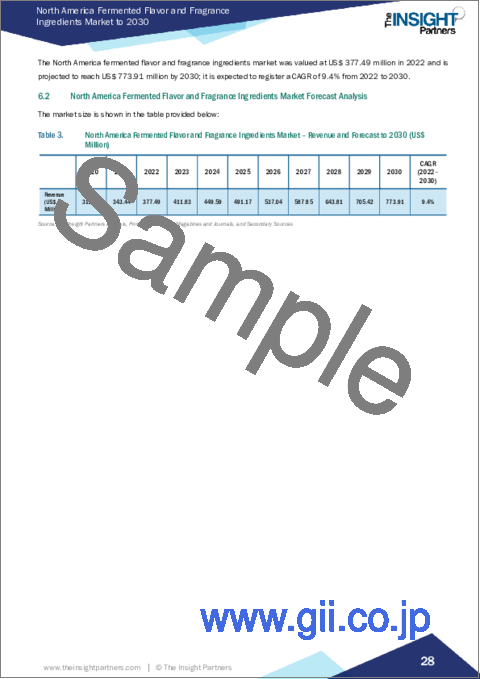|
|
市場調査レポート
商品コード
1592663
北米の発酵フレーバー・フレグランス成分市場:2030年までの予測 - 地域別分析 - タイプ別、用途別North America Fermented Flavor and Fragrance Ingredients Market Forecast to 2030 - Regional Analysis - By Type (Fruity, Floral, Woody, Blends, and Others) and Application (Food and Beverages, Personal Care Products, Cosmetics, and Others) |
||||||
|
|||||||
| 北米の発酵フレーバー・フレグランス成分市場:2030年までの予測 - 地域別分析 - タイプ別、用途別 |
|
出版日: 2024年09月16日
発行: The Insight Partners
ページ情報: 英文 100 Pages
納期: 即納可能
|
全表示
- 概要
- 図表
- 目次
北米の発酵フレーバー・フレグランス成分市場は、2022年に3億7,749万米ドルとなり、2030年までには7億7,391万米ドルに達すると予測され、2022年から2030年までのCAGRは9.4%と推定されます。
持続可能性への関心の高まりが北米の発酵フレーバー・フレグランス成分市場に拍車をかける
過去数年間、気候変動は地球の自然生態系に影響を与え、人々の幸福に重大な脅威をもたらしてきました。そのため、消費者は使用する製品が環境に与える影響を意識するようになり、持続可能な製品を好むようになっています。消費者は、環境や社会にプラスの影響を与えるなど、持続可能性の原則に取り組む企業の製品やサービスには、追加料金を支払うことを厭わないです。このように、業界の慣行は、消費者の健康志向と、持続可能性と環境的利益に対する要求に応えるために進化しています。
合成抽出プロセスで作られた香料は、化学物質やその他の化石燃料で構成されており、環境や人の健康に害を及ぼす可能性があります。化石燃料を使用して作られた香料は、炭素(CO2)排出量と温室効果ガス排出量を増加させます。例えば、バニリンと呼ばれる合成バニラ・フレーバーは、その手頃な価格と入手可能性により、天然バニラ・フレーバーよりもかなり多く使用されています。しかし、バニリンは化石燃料と木材パルプから合成製造されます。さらに、バニラのさやから抽出される天然バニラ・フレーバーの収量は極めて低いです。1Kgのフレーバーを得るのに、500Kgのバニラのさやが必要です。このように、伝統的に使用されてきた天然プロセスも、合成プロセスによる香料も、持続可能なものではありません。同様に、ラズベリーのアロマを農業で生産するには、100トン以上のラズベリーが必要であり、これはサッカー場40個分に相当します。このように、伝統的に生産されている天然成分だけでなく、合成成分の生産も環境に害を与える可能性があります。
発酵は、持続可能な方法で香料を生産するために開発された代替技術であり、「天然」とも考えられています。米国環境保護庁(EPA)の汚染防止のためのバイオエンジニアリング研究によると、発酵は従来の化学合成よりも資源効率が高く、製品別の発生が少ないため、より持続可能な生産方法です。そのため、発酵によって生産される香料は環境に害を与えず、天然で持続可能な成分として表示されます。そのため、食品・飲料、香水、化粧品、パーソナルケアなどの最終用途産業における持続可能性への関心の高まりが、世界中で発酵フレーバー・フレグランスの需要を押し上げ、市場の成長を後押ししています。
北米の発酵フレーバー・フレグランス成分市場の概要
北米は世界の発酵フレーバー・フレグランス成分市場で大きなシェアを占めています。フレーバーとフレグランスの生産におけるバイオテクノロジーの役割の拡大は、市場成長に寄与する主な要因の一つと考えられています。さらに、同地域の最終用途産業が確立していることも、香料需要を押し上げています。これらの添加物は、食品・飲料、パーソナルケア・化粧品、香水・フレグランス、ホームケア製品など、さまざまな産業に適しているからです。また、発酵技術に由来する香料は食品医薬品局(FDA)により「天然」とみなされるため、食品・飲料業界における需要を牽引しています。
さらに、合成香料による有害な影響に対する意識の高まりが、天然香料の需要を押し上げています。さらに、WHOやFDAなどの政府当局は、合成添加物の危険な影響を認識し、そのような成分を食品に使用するメーカーに対するガイドラインを定めています。その結果、消費者の健康志向の高まりからクリーンラベル製品に対する需要が急増し、この地域では発酵香料に対する需要が急増しています。食品・飲料業界と同様に、クリーンラベル原料の需要も化粧品・パーソナルケア製品メーカーの間で増加しています。このように、上記の要因は北米の発酵香料市場の成長に寄与しています。
北米の発酵フレーバー・フレグランス成分市場の収益と2030年までの予測(金額)
北米の発酵フレーバー・フレグランス成分市場のセグメンテーション
北米の発酵フレーバー・フレグランス成分市場は、タイプ、用途、国に分類されます。
タイプ別では、北米の発酵フレーバー・フレグランス成分市場はフルーティ、フローラル、ウッディ、ブレンド、その他に分けられます。2022年の北米の発酵フレーバー・フレグランス成分市場シェアは、フルーティセグメントが最大でした。
用途別では、北米の発酵フレーバー・フレグランス成分市場は、食品・飲料、パーソナルケア製品、化粧品、その他に分類されます。2022年の北米の発酵フレーバー・フレグランス成分市場シェアは、その他セグメントが最大でした。
国別では、北米の発酵フレーバー・フレグランス成分市場は米国、カナダ、メキシコに区分されます。2022年の北米の発酵フレーバー・フレグランス成分市場シェアは米国が独占しました。
Jeneil Biotech Inc、Dohler GmbH、Takasago International Corp、Givaudan SA、BASF SE、Firmenich International SA、Amyris Inc、Conagen Inc、Evolva Holding SAは、北米の発酵フレーバー・フレグランス成分市場で事業を展開する主要企業です。
目次
第1章 イントロダクション
第2章 エグゼクティブサマリー
- 主要市場洞察
- 市場の魅力
第3章 調査手法
- 調査範囲
- 2次調査
- 1次調査
第4章 発酵フレーバー・フレグランス成分市場の情勢
- ポーターのファイブフォース分析
- 供給企業の交渉力
- 買い手の交渉力
- 新規参入業者の脅威
- 競争企業間の敵対関係
- 代替品の脅威
- エコシステム分析
- 原材料サプライヤー
- 製造プロセス
- 流通業者または供給業者
- 最終用途産業
- バリューチェーンのベンダー一覧
第5章 北米の発酵フレーバー・フレグランス成分市場:主要市場力学
- 市場促進要因
- 持続可能性への関心の高まり
- 主要市場プレイヤーによる戦略的発展への取り組み
- 市場抑制要因
- 高い製品コスト
- 市場機会
- 技術の進歩
- 今後の動向
- 「クリーンラベル」と「非遺伝子組み換え」製品に対する需要の急増
- 促進要因と抑制要因の影響
第6章 発酵フレーバー・フレグランス成分市場:北米市場分析
- 北米の発酵フレーバー・フレグランス成分市場収益、2020年~2030年
- 北米の発酵フレーバー・フレグランス成分市場予測分析
第7章 北米の発酵フレーバー・フレグランス成分市場分析:タイプ別
- フルーティー
- フローラル
- ウッディ
- ブレンド
- その他
第8章 北米の発酵フレーバー・フレグランス成分市場分析:用途別
- 食品・飲料
- パーソナルケア製品
- 化粧品
- その他
第9章 北米の発酵フレーバー・フレグランス成分市場:国別分析
- 北米市場概要
- 北米
- 米国
- カナダ
- メキシコ
- 北米
第10章 競合情勢
- ヒートマップ分析:主要企業別
- 企業のポジショニングと集中度
第11章 企業プロファイル
- Jeneil Biotech Inc
- Dohler GmbH
- Takasago International Corp
- Givaudan SA
- BASF SE
- Firmenich International SA
- Amyris Inc
- Conagen Inc
- Evolva Holding SA
第12章 付録
List Of Tables
- Table 1. North America Fermented Flavor and Fragrance Ingredients Market Segmentation
- Table 2. List of Vendors
- Table 3. North America Fermented Flavor and Fragrance Ingredients Market - Revenue and Forecast to 2030 (US$ Million)
- Table 4. North America Fermented Flavor and Fragrance Ingredients Market - Revenue and Forecast to 2030 (US$ Million) - by Type
- Table 5. North America Fermented Flavor and Fragrance Ingredients Market - Revenue and Forecast to 2030 (US$ Million) - by Application
- Table 6. North America: Fermented Flavor and Fragrance Ingredients Market - Revenue and Forecast to 2030(US$ Million) - by Country
- Table 7. US: Fermented Flavor and Fragrance Ingredients Market - Revenue and Forecast to 2030(US$ Million) - by Type
- Table 8. US: Fermented Flavor and Fragrance Ingredients Market - Revenue and Forecast to 2030(US$ Million) - by Application
- Table 9. Canada: Fermented Flavor and Fragrance Ingredients Market - Revenue and Forecast to 2030(US$ Million) - by Type
- Table 10. Canada: Fermented Flavor and Fragrance Ingredients Market - Revenue and Forecast to 2030(US$ Million) - by Application
- Table 11. Mexico: Fermented Flavor and Fragrance Ingredients Market - Revenue and Forecast to 2030(US$ Million) - by Type
- Table 12. Mexico: Fermented Flavor and Fragrance Ingredients Market - Revenue and Forecast to 2030(US$ Million) - by Application
- Table 13. Heat Map Analysis by Key Players
List Of Figures
- Figure 1. North America Fermented Flavor and Fragrance Ingredients Market Segmentation, by Country
- Figure 2. Porter's Five Forces Analysis: North America Fermented Ingredients for Flavors and Fragrances Market
- Figure 3. Ecosystem: North America Fermented Flavor and Fragrance Ingredients Market
- Figure 4. North America Fermented Flavor and Fragrance Ingredients Market - Key Market Dynamics
- Figure 5. Impact Analysis of Drivers and Restraints
- Figure 6. North America Fermented Flavor and Fragrance Ingredients Market Revenue (US$ Million), 2020-2030
- Figure 7. North America Fermented Flavor and Fragrance Ingredients Market Share (%) - by Type (2022 and 2030)
- Figure 8. Fruity: North America Fermented Flavor and Fragrance Ingredients Market - Revenue and Forecast to 2030 (US$ Million)
- Figure 9. Floral: North America Fermented Flavor and Fragrance Ingredients Market - Revenue and Forecast to 2030 (US$ Million)
- Figure 10. Woody: North America Fermented Flavor and Fragrance Ingredients Market - Revenue and Forecast to 2030 (US$ Million)
- Figure 11. Blends: North America Fermented Flavor and Fragrance Ingredients Market - Revenue and Forecast to 2030 (US$ Million)
- Figure 12. Others: North America Fermented Flavor and Fragrance Ingredients Market - Revenue and Forecast to 2030 (US$ Million)
- Figure 13. North America Fermented Flavor and Fragrance Ingredients Market Share (%) - by Application (2022 and 2030)
- Figure 14. Food and Beverages: North America Fermented Flavor and Fragrance Ingredients Market - Revenue and Forecast to 2030 (US$ Million)
- Figure 15. Personal Care Products: North America Fermented Flavor and Fragrance Ingredients Market - Revenue and Forecast to 2030 (US$ Million)
- Figure 16. Cosmetics: North America Fermented Flavor and Fragrance Ingredients Market - Revenue and Forecast to 2030 (US$ Million)
- Figure 17. Others: North America Fermented Flavor and Fragrance Ingredients Market - Revenue and Forecast to 2030 (US$ Million)
- Figure 18. North America: Fermented Flavor and Fragrance Ingredients Market Breakdown, by Key Countries, (2022) (US$ Mn)
- Figure 19. North America: Fermented Flavor and Fragrance Ingredients Market Breakdown, by Key Countries, 2022 and 2030 (%)
- Figure 20. US: Fermented Flavor and Fragrance Ingredients Market - Revenue and Forecast to 2030(US$ Million)
- Figure 21. Canada: Fermented Flavor and Fragrance Ingredients Market - Revenue and Forecast to 2030(US$ Million)
- Figure 22. Mexico: Fermented Flavor and Fragrance Ingredients Market - Revenue and Forecast to 2030(US$ Million)
- Figure 23. Company Positioning & Concentration
The North America fermented flavor and fragrance ingredients market was valued at US$ 377.49 million in 2022 and is expected to reach US$ 773.91 million by 2030; it is estimated to register a CAGR of 9.4% from 2022 to 2030.
Rising Sustainability Concerns Fuel North America Fermented Flavor and Fragrance Ingredients Market
Over the past few years, climate change has affected the earth's natural ecosystems and posed a significant threat to the well-being of people. Thus, consumers are becoming conscious of the environmental impact associated with the products they use and assert a preference for sustainable ones. They are willing to pay extra for products and services from companies committed to sustainability principles, such as a positive environmental and social impact. Thus, the industry's practices are evolving to meet the health-consciousness of consumers and demands for sustainability and environmental benefits.
Flavors and fragrances made via synthetic extraction processes consist of chemicals and other fossil fuels, which can harm the environment and human health. The flavors and fragrances made using fossil fuels increase carbon (CO2) emissions and greenhouse gas emissions. For instance, synthetic vanilla flavor called vanillin is significantly more used flavor than natural vanilla flavors owing to its affordability and availability. But vanillin is synthetically manufactured from fossil fuel and wood pulp. Moreover, the yield of natural vanilla flavor extracted from vanilla pods is extremely low. It takes 500 Kg of vanilla pods to obtain 1 Kg of flavor. Thus, both the traditionally used natural process and synthetic process of flavors and fragrances are not sustainable. Similarly, the production of raspberry aroma by farming would require more than 100 metric ton of raspberries, which translates to ~40 football fields of cultivated acreage-a highly unsustainable use of land. Thus, the production of synthetic ingredients as well as traditionally produced natural ingredients can harm the environment.
Fermentation is an alternative technology developed to produce flavors and fragrances through sustainable methods and is also considered "natural." According to the US Environmental Protection Agency (EPA), Bioengineering for Pollution Prevention study, fermentation is a more sustainable method of production than traditional chemical synthesis because it is more resource-efficient and generates fewer byproducts. Thus, the flavors and fragrances produced by fermentation do not harm the environment and are labeled as natural and sustainable ingredients. Thus, rising sustainability concerns among end-use industries such as food & beverages, perfumeries, cosmetics, and personal care boost the demand for fermented flavors and fragrances across the globe, thereby favoring the market growth.
North America Fermented Flavor and Fragrance Ingredients Market Overview
North America holds a prominent share of the global fermented flavor and fragrance ingredients market. The expanding role of biotechnology in producing flavors and fragrances is considered one of the major factors contributing to the market growth. Moreover, the well-established end-use industry in the region boosts the demand for flavors and fragrances, as these additives are suitable for various industries such as food & beverages, personal care and cosmetics, perfumes and fragrances, and home care products. Also, flavors and fragrances derived from fermentation technology are considered 'natural' by the Food and Drugs Administration (FDA) which drives its demand in food & beverages industry.
Furthermore, the rising awareness about the hazardous effects of synthetic flavors and fragrances boosts the demand for natural flavors and fragrances. Additionally, government authorities, such as the WHO and FDA, have recognized the hazardous effects of synthetic additives and have laid down guidelines for manufacturers that use such ingredients in food products. As a result, the demand for clean-label products has surged owing to increasing health consciousness among consumers, and the demand for fermented flavors and fragrances has picked up pace in the region. Similar to the food & beverage industry, the demand for clean-label ingredients is also increasing among cosmetic and personal care products manufacturers. Thus, the factors mentioned above contribute to the growth of the fermented flavor and fragrance ingredients market in North America.
North America Fermented Flavor and Fragrance Ingredients Market Revenue and Forecast to 2030 (US$ Million)
North America Fermented Flavor and Fragrance Ingredients Market Segmentation
The North America fermented flavor and fragrance ingredients market is categorized into type, application, and country.
Based on type, the North America fermented flavor and fragrance ingredients market is divided into fruity, floral, woody, blends, and others. The fruity segment held the largest North America fermented flavor and fragrance ingredients market share in 2022.
In terms of application, the North America fermented flavor and fragrance ingredients market is categorized into food and beverages, personal care products, cosmetics, and others. The others segment held the largest North America fermented flavor and fragrance ingredients market share in 2022.
By country, the North America fermented flavor and fragrance ingredients market is segmented into the US, Canada, and Mexico. The US dominated the North America fermented flavor and fragrance ingredients market share in 2022.
Jeneil Biotech Inc, Dohler GmbH, Takasago International Corp, Givaudan SA, BASF SE, Firmenich International SA, Amyris Inc, Conagen Inc, and Evolva Holding SA are some of the leading companies operating in the North America fermented flavor and fragrance ingredients market.
Table Of Contents
1. Introduction
- 1.1 The Insight Partners Research Report Guidance
- 1.2 Market Segmentation
2. Executive Summary
- 2.1 Key Market Insights
- 2.2 Market Attractiveness
3. Research Methodology
- 3.1 Coverage
- 3.2 Secondary Research
- 3.3 Primary Research
4. Fermented Flavor and Fragrance Ingredients Market Landscape
- 4.1 Overview
- 4.2 Porter's Five Forces Analysis
- 4.2.1 Bargaining Power of Suppliers
- 4.2.2 Bargaining Power of Buyers
- 4.2.3 Threat of New Entrants
- 4.2.4 Competitive Rivalry
- 4.2.5 Threat of Substitutes
- 4.3 Ecosystem Analysis
- 4.3.1 Raw Material Suppliers
- 4.3.2 Manufacturing Process
- 4.3.3 Distributors or Suppliers
- 4.3.4 End-Use Industries
- 4.3.5 List of Vendors in the Value Chain
5. North America Fermented Flavor and Fragrance Ingredients Market - Key Market Dynamics
- 5.1 Market Drivers
- 5.1.1 Rising Sustainability Concerns
- 5.1.2 Strategic Development Initiatives by Key Market Players
- 5.2 Market Restraints
- 5.2.1 High Product Costs
- 5.3 Market Opportunities
- 5.3.1 Technological Advancements
- 5.4 Future Trends
- 5.4.1 Surging Demand for "Clean Label" and "Non-GMO" Products
- 5.5 Impact of Drivers and Restraints:
6. Fermented Flavor and Fragrance Ingredients Market - North America Market Analysis
- 6.1 North America Fermented Flavor and Fragrance Ingredients Market Revenue (US$ Million), 2020-2030
- 6.2 North America Fermented Flavor and Fragrance Ingredients Market Forecast Analysis
7. North America Fermented Flavor and Fragrance Ingredients Market Analysis - by Type
- 7.1 Fruity
- 7.1.1 Overview
- 7.1.2 Fruity: North America Fermented Flavor and Fragrance Ingredients Market - Revenue and Forecast to 2030 (US$ Million)
- 7.2 Floral
- 7.2.1 Overview
- 7.2.2 Floral: North America Fermented Flavor and Fragrance Ingredients Market - Revenue and Forecast to 2030 (US$ Million)
- 7.3 Woody
- 7.3.1 Overview
- 7.3.2 Woody: North America Fermented Flavor and Fragrance Ingredients Market - Revenue and Forecast to 2030 (US$ Million)
- 7.4 Blends
- 7.4.1 Overview
- 7.4.2 Blends: North America Fermented Flavor and Fragrance Ingredients Market - Revenue and Forecast to 2030 (US$ Million)
- 7.5 Others
- 7.5.1 Overview
- 7.5.2 Others: North America Fermented Flavor and Fragrance Ingredients Market - Revenue and Forecast to 2030 (US$ Million)
8. North America Fermented Flavor and Fragrance Ingredients Market Analysis - by Application
- 8.1 Food and Beverages
- 8.1.1 Overview
- 8.1.2 Food and Beverages: North America Fermented Flavor and Fragrance Ingredients Market - Revenue and Forecast to 2030 (US$ Million)
- 8.2 Personal Care Products
- 8.2.1 Overview
- 8.2.2 Personal Care Products: North America Fermented Flavor and Fragrance Ingredients Market - Revenue and Forecast to 2030 (US$ Million)
- 8.3 Cosmetics
- 8.3.1 Overview
- 8.3.2 Cosmetics: North America Fermented Flavor and Fragrance Ingredients Market - Revenue and Forecast to 2030 (US$ Million)
- 8.4 Others
- 8.4.1 Overview
- 8.4.2 Others: North America Fermented Flavor and Fragrance Ingredients Market - Revenue and Forecast to 2030 (US$ Million)
9. North America Fermented Flavor and Fragrance Ingredients Market - Country Analysis
- 9.1 North America Market Overview
- 9.1.1 North America: Fermented Flavor and Fragrance Ingredients Market - Revenue and Forecast Analysis - by Country
- 9.1.1.1 North America: Fermented Flavor and Fragrance Ingredients Market - Revenue and Forecast Analysis - by Country
- 9.1.1.2 US: Fermented Flavor and Fragrance Ingredients Market - Revenue and Forecast to 2030 (US$ Million)
- 9.1.1.2.1 US: Fermented Flavor and Fragrance Ingredients Market Breakdown, by Type
- 9.1.1.2.2 US: Fermented Flavor and Fragrance Ingredients Market Breakdown, by Application
- 9.1.1.3 Canada: Fermented Flavor and Fragrance Ingredients Market - Revenue and Forecast to 2030 (US$ Million)
- 9.1.1.3.1 Canada: Fermented Flavor and Fragrance Ingredients Market Breakdown, by Type
- 9.1.1.3.2 Canada: Fermented Flavor and Fragrance Ingredients Market Breakdown, by Application
- 9.1.1.4 Mexico: Fermented Flavor and Fragrance Ingredients Market - Revenue and Forecast to 2030 (US$ Million)
- 9.1.1.4.1 Mexico: Fermented Flavor and Fragrance Ingredients Market Breakdown, by Type
- 9.1.1.4.2 Mexico: Fermented Flavor and Fragrance Ingredients Market Breakdown, by Application
- 9.1.1 North America: Fermented Flavor and Fragrance Ingredients Market - Revenue and Forecast Analysis - by Country
10. Competitive Landscape
- 10.1 Heat Map Analysis by Key Players
- 10.2 Company Positioning & Concentration
11. Company Profiles
- 11.1 Jeneil Biotech Inc
- 11.1.1 Key Facts
- 11.1.2 Business Description
- 11.1.3 Products and Services
- 11.1.4 Financial Overview
- 11.1.5 SWOT Analysis
- 11.1.6 Key Developments
- 11.2 Dohler GmbH
- 11.2.1 Key Facts
- 11.2.2 Business Description
- 11.2.3 Products and Services
- 11.2.4 Financial Overview
- 11.2.5 SWOT Analysis
- 11.2.6 Key Developments
- 11.3 Takasago International Corp
- 11.3.1 Key Facts
- 11.3.2 Business Description
- 11.3.3 Products and Services
- 11.3.4 Financial Overview
- 11.3.5 SWOT Analysis
- 11.3.6 Key Developments
- 11.4 Givaudan SA
- 11.4.1 Key Facts
- 11.4.2 Business Description
- 11.4.3 Products and Services
- 11.4.4 Financial Overview
- 11.4.5 SWOT Analysis
- 11.4.6 Key Developments
- 11.5 BASF SE
- 11.5.1 Key Facts
- 11.5.2 Business Description
- 11.5.3 Products and Services
- 11.5.4 Financial Overview
- 11.5.5 SWOT Analysis
- 11.5.6 Key Developments
- 11.6 Firmenich International SA
- 11.6.1 Key Facts
- 11.6.2 Business Description
- 11.6.3 Products and Services
- 11.6.4 Financial Overview
- 11.6.5 SWOT Analysis
- 11.6.6 Key Developments
- 11.7 Amyris Inc
- 11.7.1 Key Facts
- 11.7.2 Business Description
- 11.7.3 Products and Services
- 11.7.4 Financial Overview
- 11.7.5 SWOT Analysis
- 11.7.6 Key Developments
- 11.8 Conagen Inc
- 11.8.1 Key Facts
- 11.8.2 Business Description
- 11.8.3 Products and Services
- 11.8.4 Financial Overview
- 11.8.5 SWOT Analysis
- 11.8.6 Key Developments
- 11.9 Evolva Holding SA
- 11.9.1 Key Facts
- 11.9.2 Business Description
- 11.9.3 Products and Services
- 11.9.4 Financial Overview
- 11.9.5 SWOT Analysis
- 11.9.6 Key Developments
12. Appendix
- 12.1 About The Insight Partners





